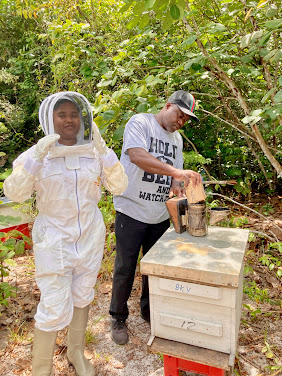 |
| Distributing seeds. |
In October,
Farmer to Farmer veteran Ira Richards returned from Nicaragua after having successfully carried out a promotional campaign for the use of
Mucuna pruriens, better known as the velvet bean. The plant, infamous for its itchiness, is widely used across the world as a forage, fallow and green manure crop, as it fixes nitrogen and fertilizes soil. Mr. Richards followed up with farmers producing the velvet bean as a nutrient supplement for their cattle and soils, providing technical assistance to further optimize the use of the beans in hopes that increased production and usage will result in better cattle nutrition, increased milk production, and more sustainable agriculture in general.
 |
| Velvet bean vines climbing a tree |
Working with the dairy cooperative San Felipe de Boaco, Mr. Richards distributed 20 pounds of velvet bean seed for demonstration trials and seed multiplication for each of the 26 farmers who participated in a planned field day at the farm of Dr. Juan Ramón Aragón. The 20 pounds of seed was enough to plant half a block. Since May 2011, Farmer to Farmer has provided approximately 20 quintals of velvet bean seed to dairy cooperatives, private ranchers, and small farmers in the communities of Boaco, Camoapa, Rivas, and Carazo.
The simplest way farmers mention using the bean is feeding its pod husk to their livestock. Some farmers give a stew of boiled beans to their milk cows, while still others prepare concentrated beans that have been treated to facilitate processing by drying or roasting the beans, then grinding them. All farmers claim increases in milk production from using the bean. In addition to its virtues as a living plant, dead vegetative matter from the velvet bean protects soil at the beginning of the rainy season and allows agricultural production in plots with steep slopes without causing water erosion.Over time, this debris adds a tremendous amount organic matter to the soil, which improves its structure, permeability, and water-holding capacity.
 |
| A field of planted beans. |




.png)

Comments
Post a Comment